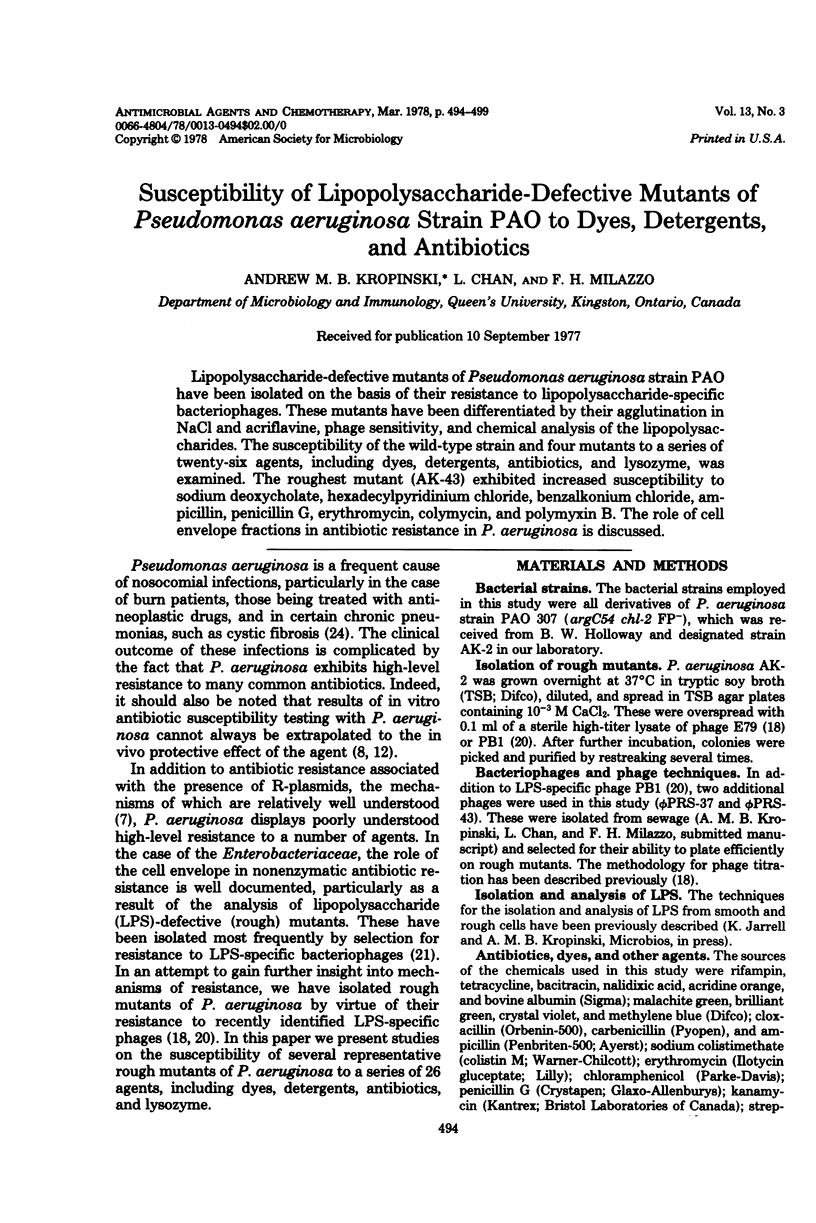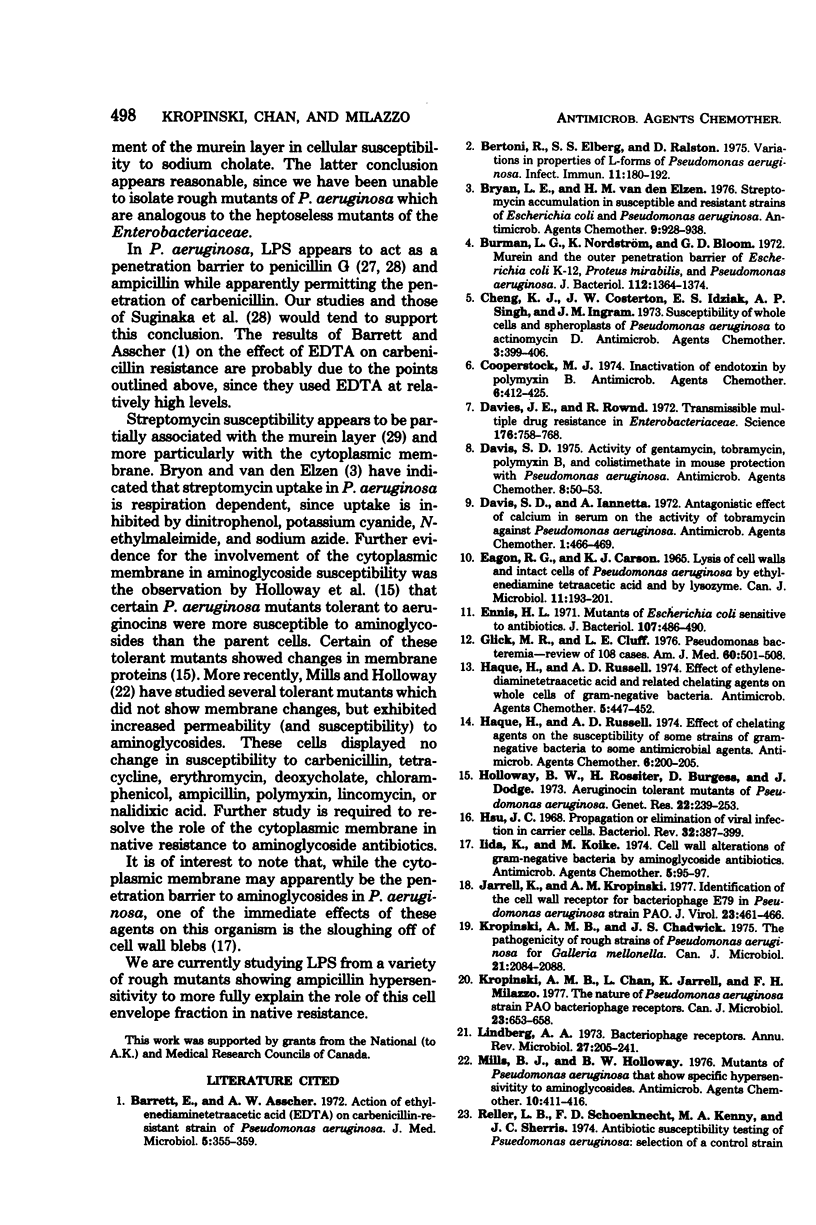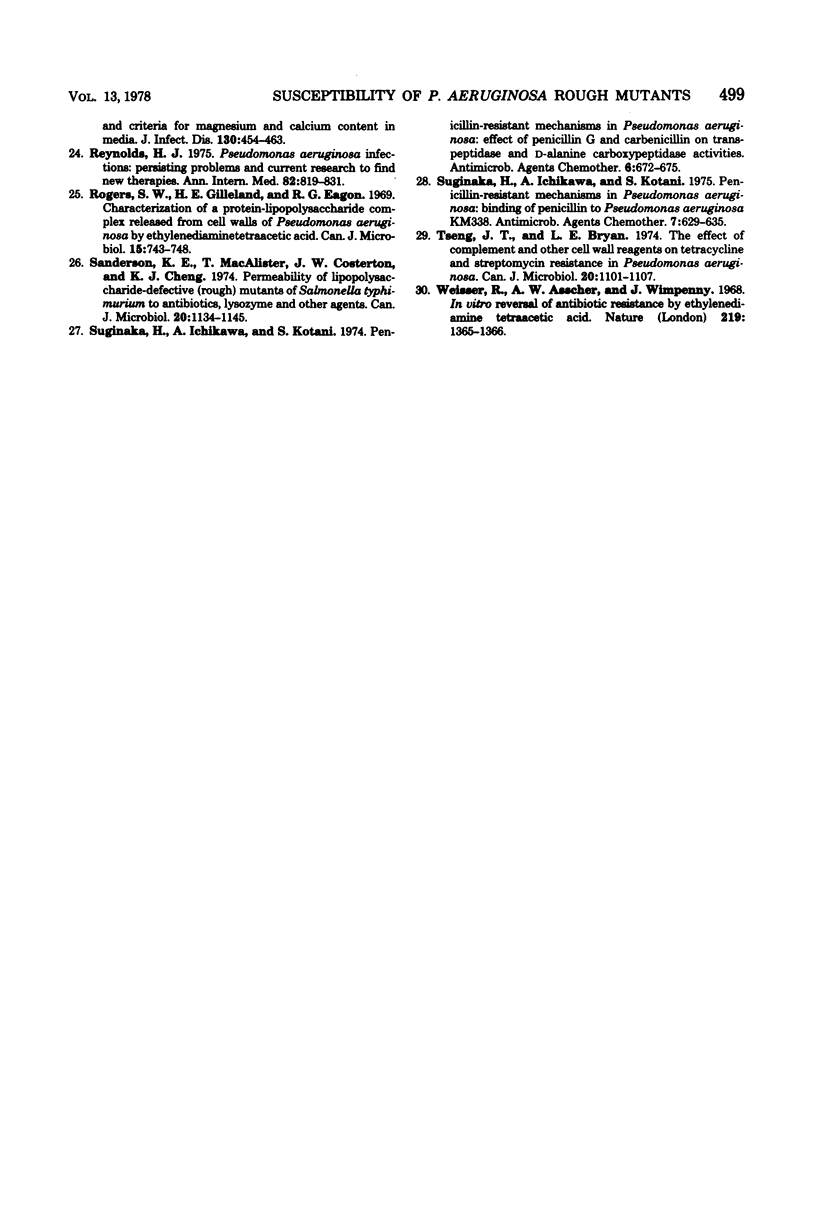Abstract
Lipopolysaccharide-defective mutants of Pseudomonas aeruginosa strain PAO have been isolated on the basis of their resistance to lipopolysaccharide-specific bacteriophages. These mutants have been differentiated by their agglutination in NaCl and acriflavine, phage sensitivity, and chemical analysis of the lipopolysaccharides. The susceptibility of the wild-type strain and four mutants to a series of twenty-six agents, including dyes, detergents, antibiotics, and lysozyme, was examined. The roughest mutant (AK-43) exhibited increased susceptibility to sodium deoxycholate, hexadecylpyridinium chloride, benzalkonium chloride, ampicillin, penicillin G, erythromycin, colymycin, and polymyxin B. The role of cell envelope fractions in antibiotic resistance in P. aeruginosa is discussed.
Full text
PDF





Selected References
These references are in PubMed. This may not be the complete list of references from this article.
- Barrett E., Asscher A. W. Action of ethylenediaminetetra-acetic acid (EDTA) on carbenicillin-resistant strains of Pseudomonas aeruginosa. J Med Microbiol. 1972 Aug;5(3):355–359. doi: 10.1099/00222615-5-3-355. [DOI] [PubMed] [Google Scholar]
- Bertolani R., Elberg S. S., Ralston D. Variations in properties of L-forms of Pseudomonas aeruginosa. Infect Immun. 1975 Jan;11(1):180–192. doi: 10.1128/iai.11.1.180-192.1975. [DOI] [PMC free article] [PubMed] [Google Scholar]
- Bryan L. E., Van den Elzen H. M. Streptomycin accumulation in susceptible and resistant strains of Escherichia coli and Pseudomonas aeruginosa. Antimicrob Agents Chemother. 1976 Jun;9(6):928–938. doi: 10.1128/aac.9.6.928. [DOI] [PMC free article] [PubMed] [Google Scholar]
- Burman L. G., Nordström K., Bloom G. D. Murein and the outer penetration barrier of Escherichia coli K-12, Proteus mirabilis, and Pseudomonas aeruginosa. J Bacteriol. 1972 Dec;112(3):1364–1374. doi: 10.1128/jb.112.3.1364-1374.1972. [DOI] [PMC free article] [PubMed] [Google Scholar]
- Cheng J. K., Costerton J. W., Singh A. P., Ingram J. M. Susceptibility of whole cells and spheroplasts of Pseudomonas aeruginosa to actinomycin D. Antimicrob Agents Chemother. 1973 Mar;3(3):399–406. doi: 10.1128/aac.3.3.399. [DOI] [PMC free article] [PubMed] [Google Scholar]
- Davies J. E., Rownd R. Transmissible multiple drug resistance in Enterobacteriaceae. Science. 1972 May 19;176(4036):758–768. doi: 10.1126/science.176.4036.758. [DOI] [PubMed] [Google Scholar]
- Davis S. D. Activity of gentamicin, tobramycin, polymyxin B, and colistimethate in mouse protection tests with Pseudomonas aeruginosa. Antimicrob Agents Chemother. 1975 Jul;8(1):50–53. doi: 10.1128/aac.8.1.50. [DOI] [PMC free article] [PubMed] [Google Scholar]
- Davis S. D., Iannetta A. Antagonistic effect of calcium in serum on the activity of tobramycin against Pseudomonas. Antimicrob Agents Chemother. 1972 Jun;1(6):466–469. doi: 10.1128/aac.1.6.466. [DOI] [PMC free article] [PubMed] [Google Scholar]
- EAGON R. G., CARSON K. J. LYSIS OF CELL WALLS AND INTACT CELLS OF PSEUDOMONAS AERUGINOSA BY ETHYLENEDIAMINE TETRAACETIC ACID AND BY LYSOZYME. Can J Microbiol. 1965 Apr;11:193–201. doi: 10.1139/m65-025. [DOI] [PubMed] [Google Scholar]
- Ennis H. L. Mutants of Escherichia coli sensitive to antibiotics. J Bacteriol. 1971 Aug;107(2):486–490. doi: 10.1128/jb.107.2.486-490.1971. [DOI] [PMC free article] [PubMed] [Google Scholar]
- Flick M. R., Cluff L. E. Pseudomonas bacteremia. Review of 108 cases. Am J Med. 1976 Apr;60(4):501–508. doi: 10.1016/0002-9343(76)90716-6. [DOI] [PubMed] [Google Scholar]
- Haque H., Russell A. D. Effect of chelating agents on the susceptibility of some strains of gram-negative bacteria to some antibacterial agents. Antimicrob Agents Chemother. 1974 Aug;6(2):200–206. doi: 10.1128/aac.6.2.200. [DOI] [PMC free article] [PubMed] [Google Scholar]
- Haque H., Russell A. D. Effect of ethylenediaminetetraacetic acid and related chelating agents on whole cells of gram-negative bacteria. Antimicrob Agents Chemother. 1974 May;5(5):447–452. doi: 10.1128/aac.5.5.447. [DOI] [PMC free article] [PubMed] [Google Scholar]
- Holloway B. W., Rossiter H., Burgess D., Dodge J. Aeruginocin tolerant mutants of Pseudomonas aeruginosa. Genet Res. 1973 Dec;22(3):239–253. doi: 10.1017/s0016672300013069. [DOI] [PubMed] [Google Scholar]
- Hsu Y. C. Propagation or elimination of viral infection in carrier cells. Bacteriol Rev. 1968 Dec;32(4 Pt 1):387–399. [PMC free article] [PubMed] [Google Scholar]
- Iida K., Koike M. Cell wall alterations of gram-negative bacteria by aminoglycoside antibiotics. Antimicrob Agents Chemother. 1974 Jan;5(1):95–97. doi: 10.1128/aac.5.1.95. [DOI] [PMC free article] [PubMed] [Google Scholar]
- Jarrell K., Kropinski A. M. Identification of the cell wall receptor for bacteriophage E79 in Pseudomonas aeruginosa strain PAO. J Virol. 1977 Sep;23(3):461–466. doi: 10.1128/jvi.23.3.461-466.1977. [DOI] [PMC free article] [PubMed] [Google Scholar]
- Kropinski A. M., Chadwick J. S. The pathogenicity of rough strains of Pseudomonas aeruginosa for Galleria mellonella. Can J Microbiol. 1975 Dec;21(12):2084–2088. doi: 10.1139/m75-297. [DOI] [PubMed] [Google Scholar]
- Kropinski A. M., Chan L., Jarrell K., Milazzo F. H. The nature of Pseudomonas aeruginosa strain PAO bacteriophage receptors. Can J Microbiol. 1977 Jun;23(6):653–658. doi: 10.1139/m77-098. [DOI] [PubMed] [Google Scholar]
- Lindberg A. A. Bacteriophage receptors. Annu Rev Microbiol. 1973;27:205–241. doi: 10.1146/annurev.mi.27.100173.001225. [DOI] [PubMed] [Google Scholar]
- Mills B. J., Holloway B. W. Mutants of Pseudomonas aeruginosa that show specific hypersensitivity to aminoglycosides. Antimicrob Agents Chemother. 1976 Sep;10(3):411–416. doi: 10.1128/aac.10.3.411. [DOI] [PMC free article] [PubMed] [Google Scholar]
- Reller L. B., Schoenknecht F. D., Kenny M. A., Sherris J. C. Antibiotic susceptibility testing of Pseudomonas aeruginosa: selection of a control strain and criteria for magnesium and calcium content in media. J Infect Dis. 1974 Nov;130(5):454–463. doi: 10.1093/infdis/130.5.454. [DOI] [PubMed] [Google Scholar]
- Rogers S. W., Gilleland H. E., Jr, Eagon R. G. Characterization of a protein-lipopolysaccharide complex released from cell walls of Pseudomonas aeruginosa by ethylenediaminetetraacetic acid. Can J Microbiol. 1969 Jul;15(7):743–748. doi: 10.1139/m69-130. [DOI] [PubMed] [Google Scholar]
- Sanderson K. E., MacAlister T., Costerton J. W., Cheng K. J. Permeability of lipopolysaccharide-deficient (rough) mutants of Salmonella typhimurium to antibiotics, lysozyme, and other agents. Can J Microbiol. 1974 Aug;20(8):1135–1145. doi: 10.1139/m74-176. [DOI] [PubMed] [Google Scholar]
- Suginaka H., Ichikawa A., Kotani S. Penicillin-resistant mechanisms in Pseudomonas aeruginosa: binding of penicillin to Pseudomonas aeruginosa KM 338. Antimicrob Agents Chemother. 1975 May;7(5):629–635. doi: 10.1128/aac.7.5.629. [DOI] [PMC free article] [PubMed] [Google Scholar]
- Suginaka H., Ichikawa A., Kotani S. Penicillin-resistant mechanisms in Pseudomonas aeruginosa: effects of penicillin G and carbenicillin on transpeptidase and C -alanine carboxypeptidase activities. Antimicrob Agents Chemother. 1974 Dec;6(6):672–675. doi: 10.1128/aac.6.6.672. [DOI] [PMC free article] [PubMed] [Google Scholar]
- Tseng J. T., Bryan L. E. The effect of complement and other cell wall reagents on tetracycline and streptomycin resistance in Pseudomonas aeruginosa. Can J Microbiol. 1974 Aug;20(8):1101–1107. doi: 10.1139/m74-172. [DOI] [PubMed] [Google Scholar]
- Weiser R., Asscher A. W., Wimpenny J. In vitro reversal of antibiotic resistance by ethylenediamine tetraacetic acid. Nature. 1968 Sep 28;219(5161):1365–1366. doi: 10.1038/2191365a0. [DOI] [PubMed] [Google Scholar]


